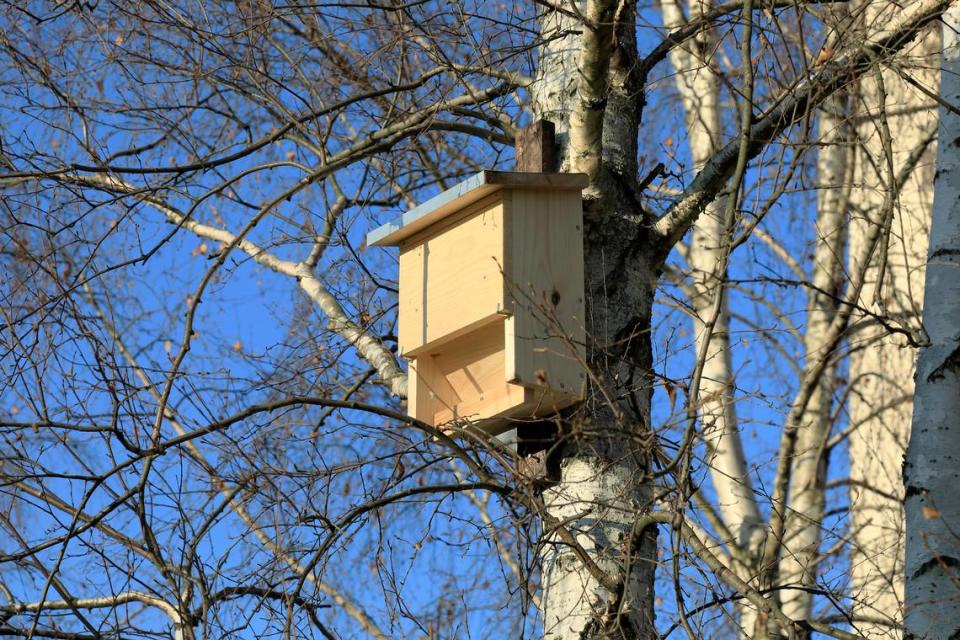You should probably install a bat house in NC this summer. Here’s why & how to do it
Wildlife experts have a solution for mosquito haters: invite bats into your yards.
Installing a bat house, experts say, is a safe, effective way to eliminate many of the pesky critters that take over yards in the summertime.
“As people learn to appreciate bats and realize the benefits that come from having bats around, it’s becoming more popular for people to install bat houses in their yards to provide a safe and comfortable place for them to live without them coming into your attic,” said Falyn Owens, extension biologist with the NC Wildlife Resources Commission.
Owens recommends consulting Bat Conservation International (batcon.org) for all things bat boxes and bat houses. Here’s what we learned:
Why install a bat house?
Bats consume a vast amount of pests, including bitey mosquitoes and unwanted garden insects.
“Just one little brown myotis can catch a thousand or more mosquito-sized insects in an hour, and a colony of 150 big brown bats can catch enough cucumber beetles each summer to prevent egg laying that otherwise could infest local gardens with 33 million rootworms,” says The Bat House Builder’s Handbook.
“Cucumber and June beetles, stinkbugs, leafhoppers, and cutworm and corn earworm moths – all well-known pests – are just a few of the many insects consumed by these frequent users of bat houses. In addition, many pests flee areas where they hear bat echolocation sounds.”
You can read The Bat House Builder’s Handbook in full at Bat Conservation International’s website.

What’s a bat house?
Bat houses are homes with ideal conditions for bats to give birth, raise their young and live within.
Putting up a bat house is a helpful way to deal with bats living in unwanted spaces, such as attics or within other dark spaces of a home.
If you carefully follow building and installation instructions, you should have an 80% success rate of attracting bats, the Handbook says.
How to make a bat house
The most effective bat houses are four-chamber houses or rocket boxes, according to Bat Conservation International.
“These houses boast a high success rate because they best mimic the types of crevices found under the peeling bark of a dead or dying tree and similar places where bats like to roost,” says The Nature Conservancy.
Rocket boxes are installed on poles, while four-chamber houses work best on a building (though they can also be perched on a pole), as buildings offer more stable temperatures.
You can build these bat habitats yourself, or you can buy them. But it’s important to know that bat boxes need to meet certain criteria to be effective, and improper ones can be harmful to bats.
• Dimensions: A bat house should be at least 24 inches high by 16 inches wide. Smaller bat houses do not offer adequate thermal stability.
• Materials: A bat house should not contain fabric or mesh. Roosting boards and landing pads should consist of roughened wood.
• Location: Don’t hang your bat box from a tree, as it allows predators (like owls and hawks) to get near the bats. Plus, you need 15 to 20 feet of space (at least 10) below the box to give the bats enough space to leave.
(Source: batcon.org/about-bats/bat-gardens-houses)
Do bat houses increase the risk of rabies?
Well-positioned bat houses are safe. Owens advises keeping bat boxes far away from front doors or other easily accessible entrances to the house, as there’s a higher chance of getting into contact with bats.
Here’s what Bat Conservation International says:
• Any wild animal can carry rabies: Bats don’t carry rabies any more than any other animal. Knowing this, if you see a bat on the ground, it’s best to use common sense and avoid touching it.
• Teach your kids to stay safe: Don’t let kids try to pick them up or touch them.
• Use heavy equipment: If you do want to pick up a bat, to bring it to a rehabber for example, you need to wear thick gloves the entire time.
Why are bats important?
Bats can spread deadly diseases to humans, so they should not be inside our living spaces. But bats are still a vital part of our ecosystem, so it’s important to protect and remove them humanely, said Katherine Etchison, bat biologist for the NC Wildlife Resources Commission.
Here’s why:
• They’re bug vacuums: “They are ecologically and economically valuable, providing free pest control as they nearly devour their own body weight in insects nightly. Their appetite increases even more during pup-rearing season,” an NCWRC press release says.
• They’re pollinators: Many bats eat insects, while others eat nectar and provide pollination for many plants, including peaches, cloves, bananas and agave, according to US Fish and Wildlife Services.
• They disperse seeds: Bats play a major role in seed dispersal, according to FWS. Bats that eat fruit are responsible for 95% of the seed dispersal that can help regrow rain forests.
Is there a bat in your attic? Here’s what to do, straight from the experts
Exposed to rabies? Here’s what treatment for people looks like (+ how much it costs)
Squirrels love chewing car wires. Here’s why — and how to get them to stop

